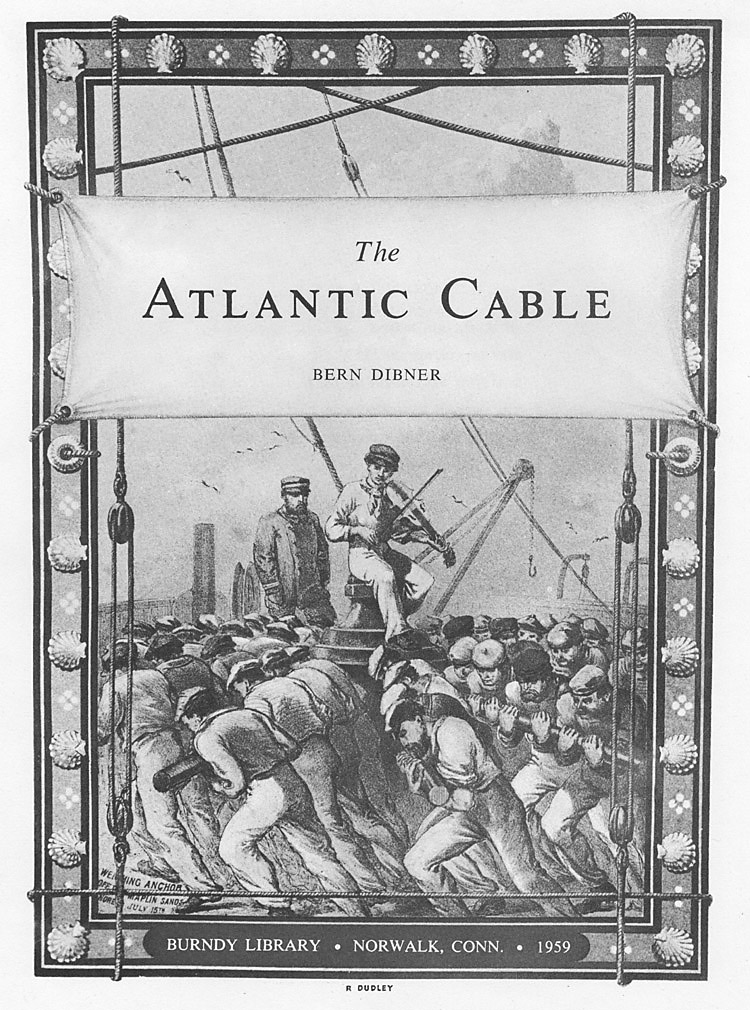Bern Dibner: The Atlantic Cable (1959)
Filed under book | Tags: · history of science, history of technology, science, technology, telegraphy

“Bern Dibner wrote a lucid chronological history of the laying of the Atlantic Cable. He covers the early experiments of Morse in New York Harbor in 1842; Ezra Cornell’s laying of a line across the Hudson River in 1845; the five actual attempts at laying the cable; and the eventual success in completing two telegraph circuits connecting Newfoundland and Ireland in 1866.
Cyrus Field was, in the words of William Thomson (later Lord Kelvin), the “originator and mainspring” of the project, which was regarded as foolhardy in many quarters. At the outset in 1854, Field realized that many electrical, mechanical, oceanographical, and nautical problems would have to be solved. Having sought and obtained encouragement of specialists in each of these areas, he was able to raise the necessary capital to finance the design, manufacture, transportation, and laying of the submarine telegraph cable. Field did not foresee, however, that the enterprise would take twelve years and forty long, hazardous trans-Atlantic crossings (the first by sailing vessel); that it woudl touch the fields of science, politics, finance, and geography; and that it would cost $12,000,000.
This book makes clear the roles of Field and Morse and Thomson, of the ships’ captains and the financial backers, and of all those who played a part in the courageous undertaking.” (source)
Publisher Burndy Library, Norwalk/Connecticut, 1959
96 pages
via Smithsonian Libraries
Videos about the transatlantic telegraph cable (via Marcell Mars):
The Great Transatlantic Cable (PBS, 120 min), torrent
Modern Marvels S01E06 – Transatlantic Cable (44 min)
History Detectives – Transatlantic Cable (PBS, 16 min)
PDF (no OCR)
Comment (0)Yongming Zhou: Historicizing Online Politics: Telegraphy, the Internet, and Political Participation in China (2006)
Filed under book | Tags: · anthropology, china, history of technology, internet, politics, technology, telegraphy, web

It is widely recognized that internet technology has had a profound effect on political participation in China, but this new use of technology is not unprecedented in Chinese history. This is a pioneering work that systematically describes and analyzes the manner in which the Chinese used telegraphy during the late Qing, and the internet in the contemporary period, to participate in politics.
Drawing upon insights from the fields of anthropology, history, political science, and media studies, this book historicizes the internet in China and may change the direction of the emergent field of Chinese internet studies. In contrast to previous works, this book is unprecedented in its perspective, in the depth of information and understanding, in the conclusions it reaches, and in its methodology. Written in a clear and engaging style, this book is accessible to a broad audience.
Publisher Stanford University Press, 2006
Asian Studies / Political Science series
ISBN 0804751285, 9780804751285
304 pages
Thomas C. Jepsen: My Sisters Telegraphic: Women in Telegraph Office 1846-1950 (2000)
Filed under book | Tags: · history of technology, labour, morse code, technology, telegraphy, women

The role of the telegraph operator in the mid-nineteenth century was like that of today’s software programmer/analyst, according to independent scholar Tom Jepsen, who notes that in the “cyberspace” of long ago, male operators were often surprised to learn that the “first-class man” on the other end of the wire was a woman.
Like the computer, the telegraph caused a technological revolution. The telegraph soon worked synergistically with the era’s other mass-scale technology, the railroad, to share facilities as well as provide communications to help trains run on time.
The strategic nature of the telegraph in the Civil War opened opportunities for women, but tension arose as men began to return from military service. However, women telegraphers did not affect male employment or wage levels. Women kept their jobs after the war with support from industry—Western Union in particular—and because they defended and justified their role.
“Although women were predominantly employed in lower-paying positions and in rural offices, women who persisted and made a career of the profession could work up to managerial or senior technical positions that, except for wage discrimination, were identical to those of their male counterparts,” writes Jepsen. “Telegraphy as an occupation became gendered, in the sense that we understand today, only after the introduction of the teletype and the creation of a separate role for women teletype operators.”
My Sisters Telegraphic is a fresh introduction to this pivotal communications technology and its unsung women workers, long neglected by labor and social historians.
Publisher Ohio University Press, 2000
ISBN 0821413449, 9780821413449
231 pages

